Why giant pandas roll in manure
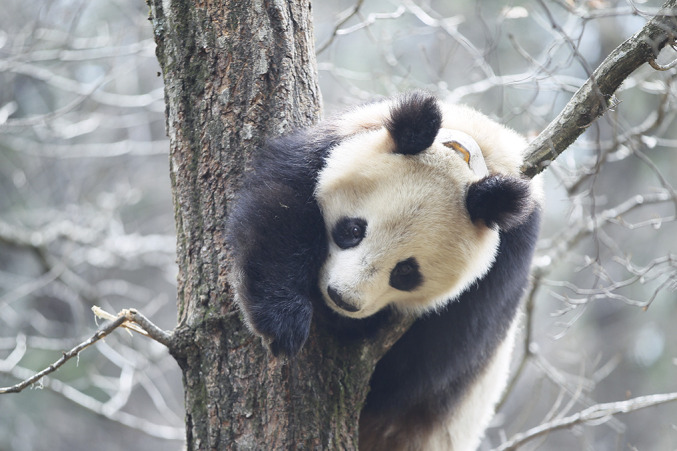
A wild panda in Foping.
Attraction to fecal matter among wild mammals is rare, but Qinling giant pandas have been observed to roll in horse manure. The behavior typically involves a panda sniffing the manure, rubbing against it with the cheek, rolling in the manure, and smearing it over its body. To uncover the purpose of the behavior, Wenliang Zhou, Shilong Yang, Bowen Li, Yonggang Nie, et al. (pp. 32493–32498) observed 38 horse-manure-rolling behaviors in giant pandas from 2016 to 2017. The frequency of manure-rolling was correlated with the freshness of the manure and with the ambient air temperature, given that almost all events were recorded at temperatures between -5 °C and 15 °C. Hypothesizing that the presence of the chemical compounds beta-caryophyllene and caryophyllene oxide in fresh manure may drive the behavior, the authors found that pandas at the Beijing Zoo in winter preferentially sniffed, rubbed, and smeared hay treated with those compounds. The authors further hypothesized that the compounds may be related to tolerance of cold temperatures and found that mice treated with the compounds exhibited increased cold tolerance. Subsequently, the authors found that beta-caryophyllene and caryophyllene oxide interacted with the pandas’ thermosensitive receptor pathway mediated by the TPRM8 protein and inhibited cold activation of the pathway. According to the authors, manure-rolling may help the pandas acclimatize to cold temperatures. — P.G.
European settlement and seabird decline
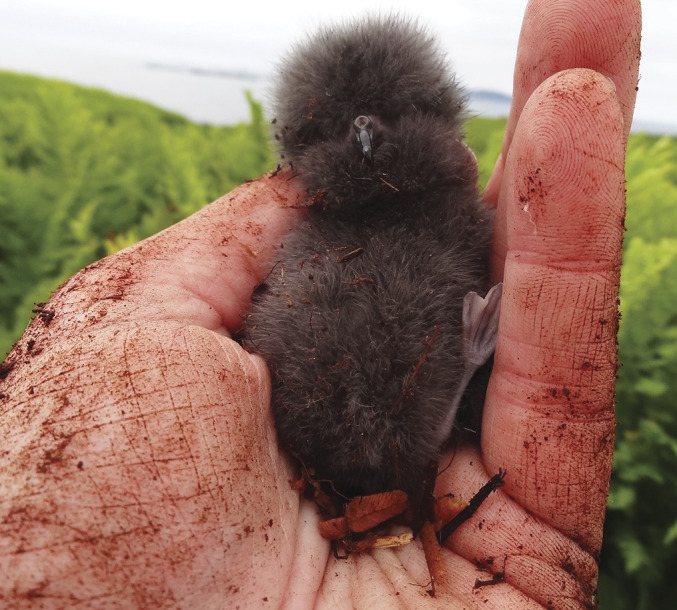
A Leach’s Storm-petrel chick.
Seabirds are key members of marine ecosystems but often lack long-term monitoring, potentially hindering conservation goals. Matthew Duda et al. (pp. 32484–32492) report a reconstruction of approximately 5,800 years of seabird population dynamics on an Atlantic island that links expanding human settlement to severe population decline of the vulnerable seabird, Leach’s Storm-petrel. The authors examined sediment cores from a pond on Grand Colombier Island in the Northwest Atlantic, home to a large breeding colony of storm-petrels. The authors analyzed the cores, representing around 5,800 years of activity, for evidence of avian waste products, such as guano, feathers, and eggshells. The authors estimated population size based on five proxies, including the composition of aquatic diatom taxa that are directly influenced by avian inputs and the concentrations of specific trace elements that would have been predominantly introduced by the birds. The results suggest that the population experienced substantial natural fluctuations until disruption occurred at the start of the 19th century, concurrent with European settlement. Currently, the island supports only around 16% of the population that was likely supported around 740 years ago. According to the authors, paleoecological approaches can help determine current rates of ecological loss and protect critical habitat. — T.H.D.
Microbial diversity in a deep-sea volcano
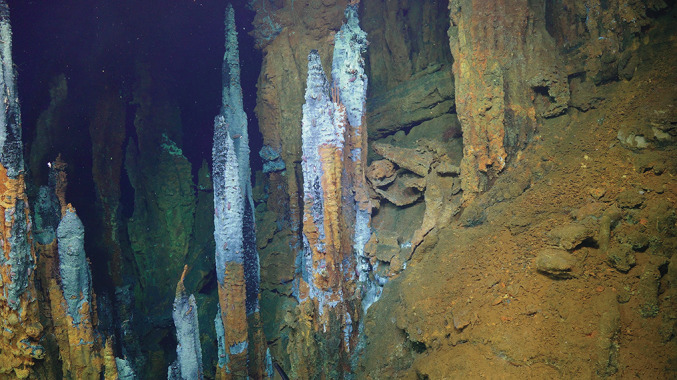
Hydrothermal vents on the caldera wall of Brothers volcano. Image credit: Anna-Louise Reysenbach, Portland State University/US-NSF/ROV Jason/2018 ©Woods Hole Oceanographic Institution.
Around 75% of global volcanic activity occurs beneath Earth’s oceans. Submarine hydrothermal systems act as mineral-rich wellsprings for deep-sea life, but the bacterial and archaeal communities that inhabit such extreme ecosystems remain incompletely described. Anna-Louise Reysenbach et al. (pp. 32627–32638) examined deposits collected from active hydrothermal vents and combined metagenomics and geological history to infer the physiology of microbial life at the Brothers submarine arc volcano, situated north of New Zealand. The analysis revealed 90 new putative bacterial and archaeal genomic families and nearly 300 previously unknown genera, and identified three distinct communities with phylogenetic differences corresponding to different hydrothermal circulation regimes. The authors note that mixing of hydrothermal fluids from these distinct systems potentially explains the high diversity in microbial communities surrounding Brothers volcano. The study demonstrates that magmatic activity, geologic history, and circulation contribute to the composition of microbial communities associated with deep-sea volcanism. According to the authors, microbial diversity in these communities could be used to infer subsurface volcanic activity and hydrothermal processes at submarine volcanoes. — T.J.
Multiscale model of plant tropism
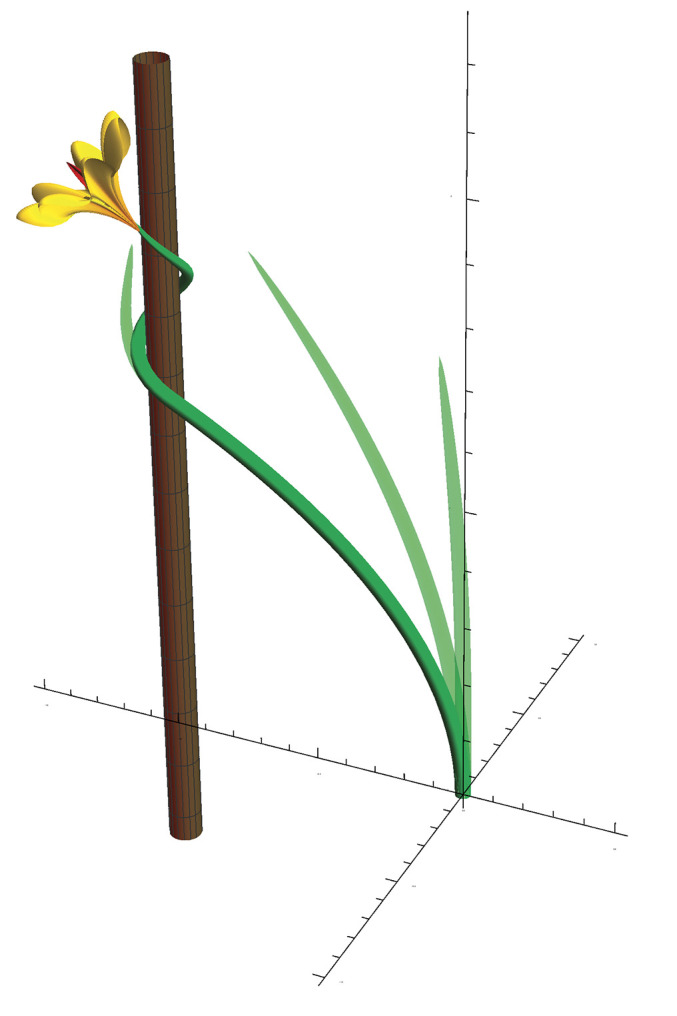
Modeling the ability of a climbing plant to wrap around a pole.
Plants respond to external stimuli such as light or gravity by growing and changing their shape, a process known as tropism. Plant tropism involves the integration of multiple environmental signals at different locations and scales, and developing a mathematical model of tropism has been challenging. Derek Moulton, Hadrien Oliveri, and Alain Goriely (pp. 32226–32237) developed a general mathematical framework that links different scales to connect environmental stimuli to plant shape and that can simulate multiple tropisms across different plant types. The authors modeled cellular transport of the growth hormone auxin in response to environmental signals and connected auxin distribution to tissue-level growth and deformation. Next, the authors modeled how these tissue-level changes in turn generate mechanical forces that lead to 3D changes to the plant’s shape and position in response to stimuli. The authors simulated and analyzed examples, including gravitropism, phototropism, and photogravitropic responses. The framework showed how integration of multiple stimuli and competing tropisms can lead to a variety of complex behaviors, from sun following to the ability of climbing plants to find and wrap around poles. According to the authors, this kind of integration of conflicting signals provides a model of plants as problem-solving systems and helps unravel plant tropisms. — S.R.
DNA methylation marks are inherited in honey bees

Honey bees. Image credit: Pixabay/PollyDot.
Epigenetic inheritance involves the intergenerational transfer of molecular marks, which can affect gene activity through chemical modifications to DNA rather than through alterations of the DNA sequence. Inheritance of epigenetic marks such as DNA methylation is rare in mammals, but relatively little is known about the evolutionary significance of epigenetic inheritance or its prevalence in nonmammalian organisms. Boris Yagound et al. (pp. 32519–32527) investigated epigenetic inheritance in honey bees, focusing on the transfer of DNA methylation marks from fathers to daughters. The authors artificially inseminated three queens with semen from four males and examined DNA methylation patterns through whole genome bisulfite sequencing on semen from the fathers and thorax tissue from fathers, daughters, and unrelated bees. DNA methylation patterns were more similar between fathers and daughters than between unrelated males and females from different generations, even after controlling for environmental factors. Tissue samples from father-daughter pairs had twice as many shared methylated DNA sites and four times fewer differentially methylated DNA sites compared with unrelated pairs of bees. According to the authors, epigenetic inheritance might play an important evolutionary role in transferring information between generations of invertebrates. — J.W.
Differences in ancient Peruvian diets
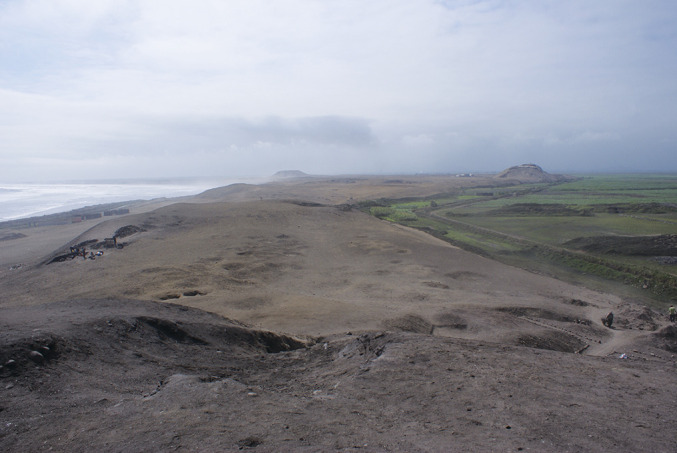
View from the top of the Huaca Prieta mound in north coastal Peru. The dark Paredones mound can be seen in the near-center of the photo, roughly between the Moche (400–750 CE) pyramids in the distance.
Early human diets affected regional economies. However, food consumption practices of pre-Hispanic communities in the Central Andes are not well understood. To determine ancient diets in Huaca Prieta and Paredones—two sites in north coastal Peru dating to approximately 7,500 to 4,000 years ago—Tiffiny Tung et al. (pp. 32308–32319) analyzed teeth from the remains of 21 individuals excavated from Huaca Prieta and nine individuals excavated from Paredones. Although Huaca Prieta and Paredones are only a few hundred meters apart, their communities had significantly different diets. Isotopic analyses revealed that Paredones children primarily consumed maize—likely in the form of a beverage or gruel during the weaning period—suggesting that early uses of maize were influenced by breastfeeding mothers. Dental microwear analyses demonstrated that the diets of Paredones adults were high in abrasives, likely from maize and foods prepared on grinding stones. The diets of Huaca Prieta children and adults were primarily composed of soft food from nonmaize plants and marine resources, such as fish and sea lions. Compared with Huaca Prieta children, Paredones children exhibited greater consumption of maize and terrestrial meat. The findings suggest that diet differences in ancient communities in close proximity may have created opportunities for resource exchange and economic specialization, according to the authors. — M.S.
Warming tundra and volatile organic carbon emission

VOC emissions were measured from enclosed tundra vegetation communities in different locations in the Arctic.
The release of volatile organic compounds (VOCs) from plants is a temperature-dependent phenomenon. Although the rapidly warming Arctic is expected to significantly increase VOC emissions, the relative contributions of temperature increase and vegetation change are unknown. Riikka Rinnan et al. (pp. 32476–32483) compiled data from warming experiments conducted in the Arctic tundra and from dynamic ecosystem models to assess VOC emissions in a warming climate. The analysis suggests that while the indirect effects of warming on VOC emissions, namely extension of the growing season and vegetation changes, are significant, they are smaller than the direct effects of temperature. Large geographical variations in VOC emissions across the Arctic are likely and dependent on local vegetation cover and climate conditions. Thus, the response of VOC emissions in the Arctic tundra is likely to be complex and interconnected, involving the local climate, vegetation, and interactions between the ecosystem and atmosphere, with local and regional scales of atmospheric impact. According to the authors, the increased VOC emissions from the tundra may affect climate feedbacks, particularly through the formation of atmospheric particles and clouds as well as altered atmospheric chemistry. — P.G.
Uncovering tectonic plate movement without fossil help
The origins of mountain belts formed by plate tectonics are typically determined by analyzing fossils located within their strata. However, the limited fossil record of the Precambrian area renders analysis of tectonic plate movement difficult. A. M. Celâl Şengör et al. (pp. 32278–32284) reconstructed the tectonic environments of North Africa and the Arabian Peninsula and report the formation of an ancient mountain belt, the Saharides, 500–900 million years ago, before the final collision of east and west Gondwana-Land. To identify essential mountain-building processes, the authors examined the geochemistry and structural geology of the existing Precambrian rock record and attempted to distinguish juvenile from reworked crust material. The samples were not discrete, but part of a belt of mountains formed over a 400-million-year period by subduction and accretion of rocks that simultaneously became stacked by strike-slip faults into large crustal panels. Analysis of magnetic anomalies suggested that the mountain belt may have been bent twice after its formation, similar to the Hercynian double orocline in western Europe. The Saharides’ formation likely added 3–5 million km2 of material to the continents. According the authors, the method could be used to reconstruct other complex mountain formations, or orogenic, systems. — T.H.D.


